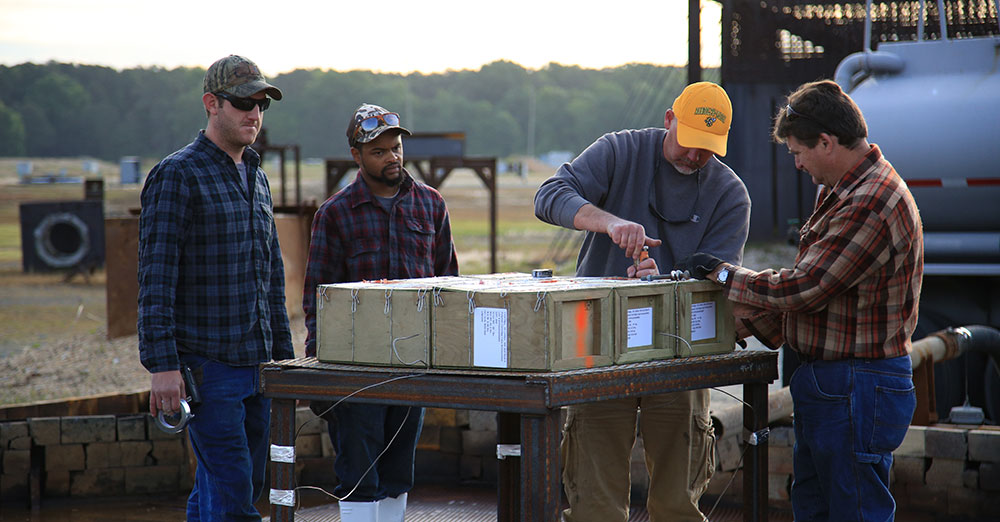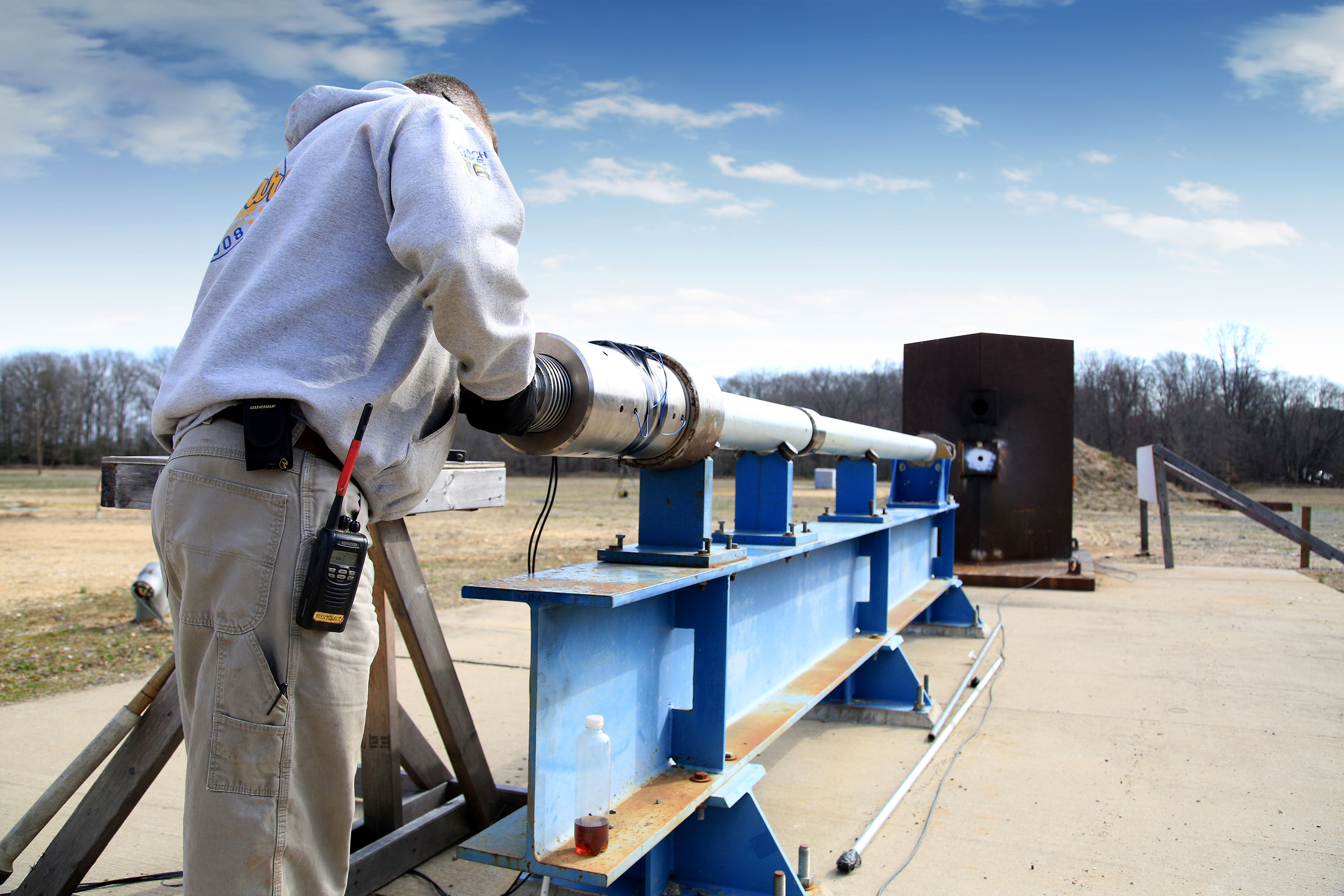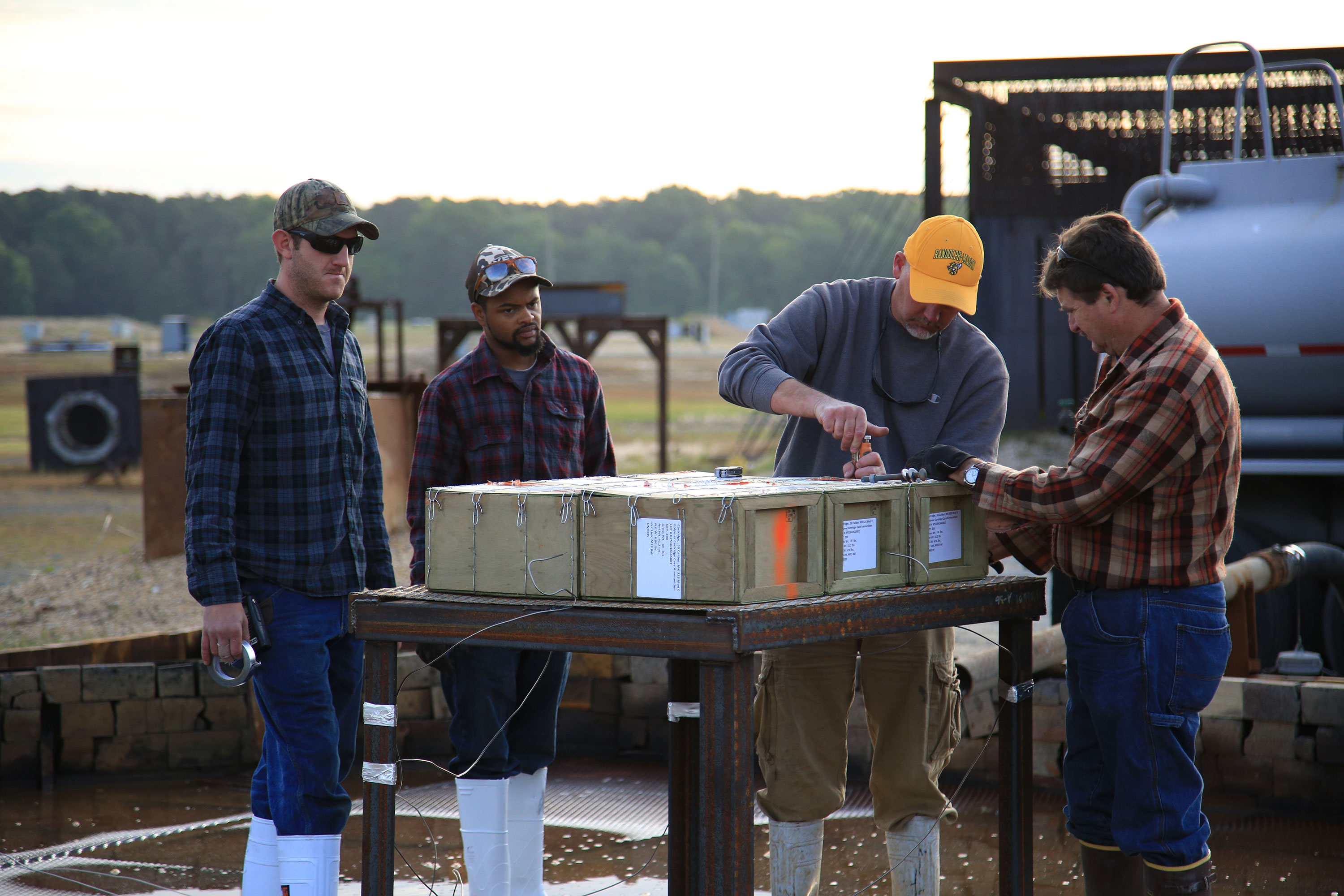
Heat, Shock, and Friction
By Tom Crisafulli
Special Guest Writer
Heat, shock, and friction: Day 1, Lesson 1
Three things were ingrained in my mind as a student at the Navy’s Explosive Ordnance Disposal (EOD) School over 30 years ago. Heat, shock, and friction: three forces you never expose any type of explosive item to. Made sense to me back then; still makes sense to me today. Even though exposing all types of explosive items to heat, shock, friction, and more is exactly how my coworkers and I earn a living every day.
We are the workers assigned to Dahlgren’s Explosive Experimental Area (EEA), otherwise known as Pumpkin Neck. EEA is a multi-site, explosive and weapons testing area quietly tucked away across Machodoc Creek from the mainside of the Dahlgren base. Many “main-side” employees may not even know this part of Dahlgren exists or what our mission is.
In layman’s terms, EEA tests all types of explosives, weapons, and nonexplosive items. We assess their safety for storage, transport, and use in the field before these items are fielded to our servicemen and servicewomen. We simulate many of the worst things that can happen to a munition in the field under strict test criteria and safety guidelines. It’s our mission to purposely expose these explosive items to heat, shock, and friction.
What types of explosive items? Literally, just about anything. We conduct testing for all four military services and other agencies, not just the Navy. Of course, as long as the potential effects of any testing involved stays within the safety footprint assigned to each EEA test area. Grenades, small arms ammunition, Navy/Army projectiles, fuzes, propellants, bulk explosives, rockets, missiles, launchers, fire control systems, and more.
What types of testing? Here are just a few:
Environmental Tests:
-
Drop tests: packaged and unpacked items are dropped from heights as high as 40 feet.
-
Temperature shock tests: munitions are subjected to temperature extremes ranging from -80F to +160F.
-
Vibration tests: items are subjected to these conditions sometimes for weeks to evaluate their suitability for use in the field by simulating real-world transportation scenarios.
Insensitive Munitions (IM):
-
Bullet impact tests: packaged and unpackaged items are shot with three .50 caliber bullets, each required to hit within a two-inch circle, within milliseconds of each other.
-
Fragment impact tests: explosive items are shot with a single steel fragment at speeds over 8,000 feet per second.
-
Arena testing: explosive items are placed on a test stand with target materials set at specific distances and remotely detonated to evaluate fragmentation effects and lethality.
-
Fast cook tests: munitions are subjected to fuel fires generated by igniting over 2,000 gallons of jet fuel and evaluated for their reaction.
-
Slow cook tests: explosive items are subjected to slowly rising temperatures over a period of days and evaluated for their reaction.
-
Restrained fire tests: rocket motors are functioned under varied conditions.
-
X-ray testing: pre- and post-test radiography of explosive items is often required to fully evaluate the effects of testing.
These, plus many other types of tests, are just some of the capabilities we have at EEA. Heat, shock, and friction.
In addition to the strict safety and test criteria required by each phase of this testing are the instrumentation requirements necessary to capture the data associated with each explosive event. High-speed cameras, pressure gauges, accelerometers, and other types of instrumentation equipment need to be safely and precisely set up, not only to survive the test event but to capture vital information during the actual explosive event. Merely subjecting an explosive item to a test without capturing the required data is meaningless. Precise camera angles and distances and other instrumentation requirements are spelled out in painstaking detail to fully document each test.
Many of the tests also require plotting a post-test debris field. This entails searching the test range for any identifiable fragments of the test item after it reacts to the testing environment (i.e. after it blows up). Literally, hundreds of pieces of previously intact munition pieces are located over distances as far as 300 feet away from the test site. Each tiny piece is marked with a flag. Its distance and angle from the test site is annotated. After each piece is collected from the field, it is weighed and documented with photos. This is a painstaking but vital requirement when conducting IM tests.
The journey
Up to this point, it’s been relatively easy to describe the mission and types of tests conducted at EEA. Surprisingly, the next part is proving a bit more difficult to write. Finding the appropriate words to fully convey what it means to do this kind of work day to day is a lot harder than I thought it would be. How do you translate what it feels like to work up close and personal with explosives and munitions for a living; especially ones that had been treated so badly? Things shot, burned, dropped, shaken, and more. Heat, shock, and friction. How do you translate that feeling in your stomach every time you and your coworkers go out to the range? What does it feel like to drop an SM-3 with 3,000 pounds of propellant from a height of 40 feet and then have to determine whether or not that missile is safe to approach and then move? Who would want to do this kind of work in the first place? Sports analogies like “keeping your head in the game” or “being on the ball” fall way short of the attention and respect this totally unforgiving type of work requires. There is so much more at stake.
EEA test range personnel are as varied as the types of tests they conduct. There is no one specific type of person or personality that fits into this type of job; however, it’s definitely not for everyone. The word “team,” as overused as it is, precisely describes the atmosphere among EEA personnel. It was true in my active-duty EOD days and is no less true today. Every person, regardless of background or experience, goes through extensive training and mentoring. Study guides, written tests, one-on-one interviews, certification boards, and on-the-job training are just part of the qualification process each of us must successfully complete. The bar is set pretty high when you literally put your life in the hands of the people you work with every day. There can be no doubts in your mind about the suitability or trustworthiness of the coworker on the other end of the wire when inserting a detonator into an explosive item.
The reward
The uniqueness of the testing conducted at EEA is only matched by the true uniqueness of the personnel conducting these tests. It’s an exceptional person that has the ability to leave the stresses and distractions of everyday life behind, ignore the weather conditions, and focus on the task at hand day after day. I can’t think of a job more vital to the mission of our military personnel. Knowing we’ve played a part in making the work of our servicemen and servicewomen safer gives all of us at EEA a great sense of pride. There’s no other work or other place like EEA—the home of heat, shock, and friction.

Mike Blaser prepares the EEA, 40mm Fragment Impact gun for an 8,000 feet per second shot.

Brandon Staples, Devon Bushrod, Jason Zirkle, and Henry Bourne prepare a test fixture and test items for a Fast Cook Off test.

Henry Bourne prepares thermite grenade for 2,000 jet fuel, fast cook off test initiation.